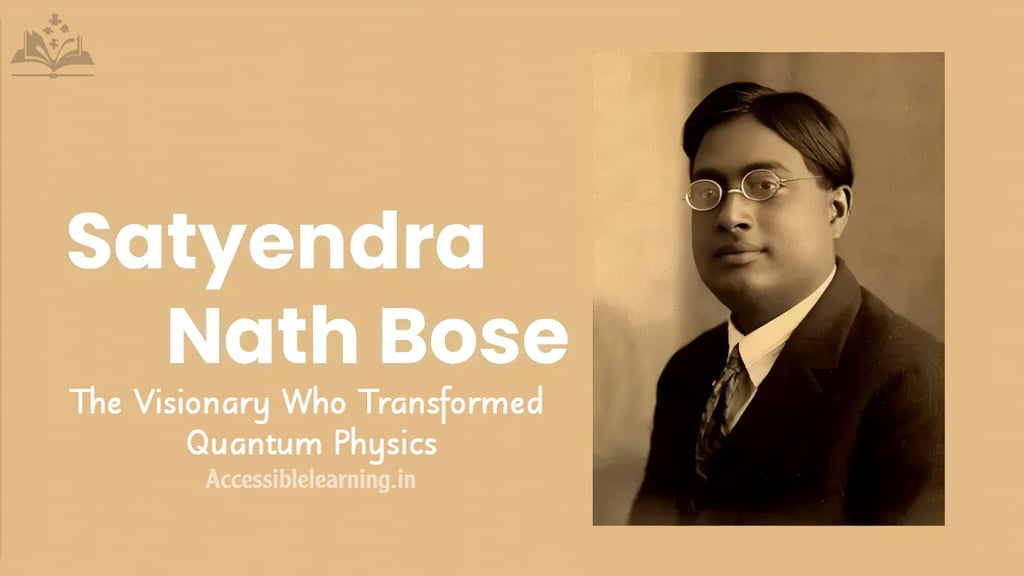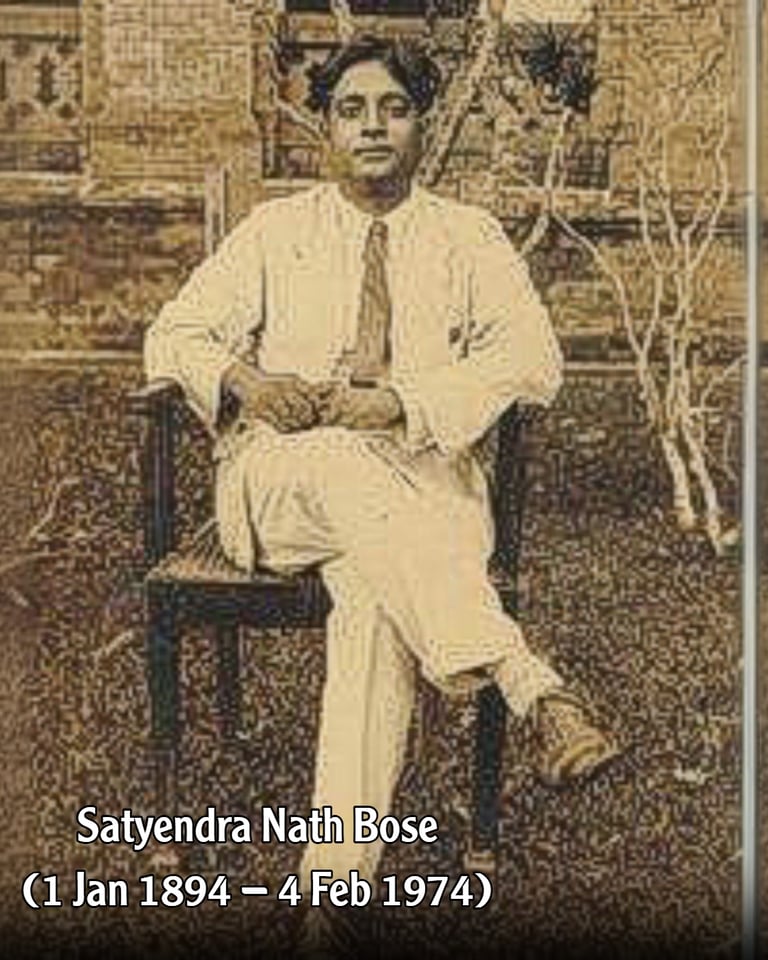
Satyendra Nath Bose: The Visionary Who Transformed Quantum Physics!
Discover the life and legacy of Satyendra Nath Bose Ji, the pioneering physicist behind Bose-Einstein statistics and bosons. Explore his groundbreaking contributions to quantum mechanics, collaboration with Albert Einstein, and enduring impact on modern science and technology.
SCIENCE/PHILOSOPHYBIOGRAPHYGREAT SCIENTISTSPACE/TECHEDUCATION/KNOWLEDGE
Sachin K Chaurasiya
12/27/20245 min read


Satyendra Nath Bose (सत्येंद्र नाथ बोस), a name that echoes through the corridors of modern physics, was an Indian mathematician and physicist whose groundbreaking work laid the foundation for quantum mechanics. Known primarily for his collaboration with Albert Einstein, which gave rise to the Bose-Einstein statistics and Bose-Einstein condensate, Bose’s contributions extend far beyond these celebrated achievements. This article delves into the life, legacy, and scientific brilliance of this extraordinary mind, whose work continues to influence physics to this day.
Early Life & Education
Born on January 1, 1894, in Calcutta (now Kolkata), Satyendra Nath Bose (सत्येन्द्र नाथबोस) was the eldest of seven children. His father, Surendranath Bose (सुरेन्द्रनाथ बोस), worked as an accountant in the East Indian Railway Company, and young Bose displayed an early aptitude for mathematics and science. Encouraged by his family, he pursued an education that would set him apart as one of the brightest minds of his generation.
Bose completed his schooling at the prestigious Hindu School in Kolkata and later graduated with a Bachelor of Science in Mathematics from Presidency College. He was mentored by prominent teachers like Jagadish Chandra Bose and Prafulla Chandra Ray, who profoundly influenced his scientific journey. In 1915, he earned a master’s degree in mixed mathematics from the University of Calcutta, securing the top position with a record-breaking score that remains unbroken to this day.
During his early years, Bose exhibited an insatiable curiosity and a strong inclination toward problem-solving, often delving into mathematical puzzles and theoretical concepts beyond his coursework. His exposure to the works of physicists like Planck, Einstein, and Schrödinger during his studies shaped his intellectual trajectory.
The Path to Quantum Physics!
Bose’s academic career began as a lecturer in physics at the University of Calcutta. However, his passion for research soon led him to explore the frontiers of theoretical physics. In the early 1920s, quantum mechanics was an emerging field, challenging classical understandings of physical phenomena. Bose became deeply interested in the behavior of photons and their statistical distribution.
In 1924, while working at the University of Dacca (now in Bangladesh), Bose wrote a groundbreaking paper titled Planck's Law and the Hypothesis of Light Quanta. In this seminal work, Bose derived Planck's radiation law by treating photons as indistinguishable particles, introducing the concept of quantum statistics. This revolutionary idea, which applied to particles now known as “bosons,” challenged classical statistics and laid the groundwork for what we now call Bose-Einstein statistics.
Bose’s paper proposed a new way of counting particles based on their indistinguishable nature. This idea was so novel that it initially faced rejection from peer-reviewed journals. Undeterred, Bose sought the opinion of Albert Einstein, marking the beginning of a collaboration that would change the course of physics.
Collaboration with Albert Einstein
Bose’s paper faced initial rejection from prestigious journals, but undeterred, he sent it directly to Albert Einstein, along with a letter explaining his innovative approach. Einstein immediately recognized the significance of Bose’s work. Not only did he translate the paper into German, but he also had it published in the renowned journal Zeitschrift für Physik. This marked the beginning of a historic collaboration.
Einstein expanded on Bose’s ideas, applying them to atoms and predicting a new state of matter—the Bose-Einstein condensate. This state occurs at extremely low temperatures, where particles occupy the same quantum state, behaving as a single quantum entity. Decades later, in 1995, this prediction was experimentally verified, earning physicists Eric Cornell, Wolfgang Ketterle, and Carl Wieman the Nobel Prize in Physics. Unfortunately, Bose himself never received the Nobel Prize, despite his foundational contributions.
Their collaboration also sparked discussions on other aspects of quantum mechanics, with Bose playing a significant role in introducing statistical methods to study particle behavior. Einstein’s acknowledgment of Bose’s genius remains one of the most iconic partnerships in scientific history.


Scientific Legacy & Contributions!
While Bose is best known for his work on quantum statistics, his contributions to science were vast and multifaceted. He conducted pioneering research in fields such as
X-Ray Crystallography: Bose contributed to understanding the crystal structure of materials, which has applications in material science and chemistry.
Electromagnetic Wave Propagation: He explored the interaction of electromagnetic waves with the ionosphere, which has implications for communication technologies.
Unified Field Theory: Bose also ventured into the realm of unified field theory, attempting to bridge the gap between different forces of nature.
Mathematical Physics: His explorations in higher-dimensional mathematics influenced later studies in quantum field theory.
As a teacher and researcher, Bose was deeply committed to advancing science in India. He was instrumental in establishing modern physics research in the country, mentoring countless students who carried forward his legacy. His contributions were recognized with prestigious accolades, including the Padma Vibhushan, India’s second-highest civilian award, in 1954. He was also appointed as a Fellow of the Royal Society in 1958.
Bose’s emphasis on indigenous research and development inspired the establishment of scientific institutions in post-independence India, contributing to the nation’s scientific self-reliance.
Beyond Science: The Polymath!
Bose was more than just a physicist; he was a true polymath. Fluent in multiple languages, including Bengali, English, French, and Sanskrit, he had a profound appreciation for literature, music, and art. He was an accomplished musician and a lifelong advocate for the preservation and promotion of Indian classical music. Bose believed in the interconnectedness of science and the arts, often emphasizing that creativity and curiosity drive both disciplines.
He was also deeply engaged with social issues, advocating for education reform and the democratization of science. Bose envisioned a world where scientific knowledge was accessible to all, irrespective of socioeconomic barriers. His efforts to promote science education in local languages stand as a testament to his belief in inclusivity.
The Human Side of a Genius
Despite his towering intellect, Bose remained approachable and modest. He believed in the democratization of knowledge and was committed to making science accessible to all. As a teacher, he encouraged critical thinking and curiosity, often stating that the pursuit of knowledge was more important than the accolades it brought.
One of the most poignant aspects of Bose’s life is his lack of a Nobel Prize. While this omission has often sparked debates in scientific circles, Bose himself was never concerned about recognition. For him, the joy of discovery and the opportunity to contribute to human understanding were reward enough.
Bose’s humility was also reflected in his interactions with students and peers, where he prioritized collaborative learning and mutual respect.
A Lasting Impact
Satyendra Nath Bose passed away on February 4, 1974, but his legacy continues to thrive. "Boson,” used to describe particles that obey Bose-Einstein statistics, immortalizes his contributions to quantum mechanics. Bosons, including the Higgs boson—famously referred to as the "God particle"—are fundamental to our understanding of the universe.
In addition to his scientific contributions, Bose’s life serves as a testament to the power of perseverance, intellectual curiosity, and the unyielding pursuit of knowledge. Institutions worldwide continue to honor him through research initiatives, lectures, and awards in his name.
His work has also inspired interdisciplinary studies, bridging physics, mathematics, and engineering. The principles of Bose-Einstein statistics have applications in fields ranging from quantum computing to condensed matter physics, influencing innovations that shape modern technology.


Satyendra Nath Bose was more than a physicist; he was a visionary whose work bridged the gap between theoretical insights and practical applications. His contributions laid the foundation for some of the most transformative discoveries in physics, influencing areas as diverse as quantum computing, particle physics, and materials science.
As we continue to unravel the mysteries of the universe, Bose’s legacy reminds us of the unyielding power of curiosity and the profound impact one mind can have on the world. Through his life and work, Satyendra Nath Bose remains an enduring symbol of scientific excellence, intellectual humility, and human potential.
Subscribe To Our Newsletter
All © Copyright reserved by Accessible-Learning Hub
| Terms & Conditions
Knowledge is power. Learn with Us. 📚


